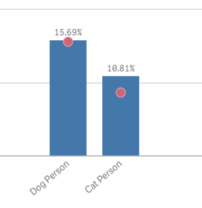Are You Fundraising With a Sledgehammer While Looking Out the Rearview Mirror?
What do you know about your donors? Not generalities but specifics about your donors and why they support your cause?
One generality common across most groups is that “our donors are older”. The precondition here is that younger people are less likely to stick around (and/or give in first place) than older people.
If your organization does sustainer acquisition, especially canvassing, then you likely have age quotas to address this generality. This is Sledgehammer Fundraising in acquisition – big, sweeping rules that create inefficiency that has to rear its head somewhere, either in lower margins for the agency or higher costs to acquire for you.
But some young(er) people are still signed up. And what about the older people, that don’t all stick around. Do you know which younger people and older people are at risk before they quit?
If all you have is age as your “understanding” then you’re stuck with your sledgehammer and treating everyone the same.  The sledgehammer approach then morphs into rearview mirror fundraising as we wait for the ‘good’ (stay) and ‘bad’ (leave) donors to reveal themselves in the monthly payment data.
The sledgehammer approach then morphs into rearview mirror fundraising as we wait for the ‘good’ (stay) and ‘bad’ (leave) donors to reveal themselves in the monthly payment data.
It doesn’t need to be this way. This chart shows donors grouped by age with the height of the bar being the percentage at-risk of quitting – not quit already but are at risk of doing so. And the specific individuals in each bar are known. The only thing required to parse out at-risk from safe is additional insight – data – about your donors. Not random and not purchased but zero-party data (and some 1st party) that is voluntarily and willingly provided by your donors.

It’s free and has enormous value. Examples?
We know the quality of the sign-up experience matters. This is one factor under your control that can be measured and when you do, you can trade in your sledgehammer for at least a mallet.
What’s more, you can start to look out the windshield by contacting the 9% of 60-80 year olds who are at risk of quitting because you know their “why” – the experience wasn’t good. There are reams of evidence that apologizing for a bad experience makes those donors more likely to stick around than the ones who had a good experience (all other things equal). How much does an apology cost? A fortune if you don’t know who to direct it towards. A few bucks (in donor service time) if you do and the upside is realizing substantial lifetime value for that individual.
However, the new donor’s experience with the organization is not all that matters. Nor is it all the free data that is available to you if only your organization will assign as much value to knowing your donors as it does to their bank account.

We didn’t need to guess at whether the person signing up to this animal welfare charity was a dog person or a cat person. Nor did we need to rely on low quality, third party data that might use consumer purchase behavior (for example) to ordain our dog and cat lovers. You ask them.
And why not ask this fundamental, important and defining question as part of the acquisition process to then have your landing page (online donor) or conversation (TM or F2F) or welcome pack (mail) be more relevant and responsive to who they are and why they support you? In most of those channels you get the data for everybody; a true census not a sample.
Now I know – before it happens – that my dog people are more at risk than my cat people (16% at risk vs 11% respectively) and I’m acquiring a lot more dog people (height of red dot in the graph above). Doesn’t it make sense to send dog pictures to dog people and cat to cat? That is really easy to pull off. You’ve now replaced your sledgehammer first with a mallet, and now with a scalpel.
You know something of material importance about your donors that isn’t a generality that gets reduced down to sledgehammer (one size fits all) and rearview mirror practice. It isn’t enough to know why donors support you in general or basic demographic trends about your file. There is no competitive advantage in that data, nor any insight.
As we’ve written many times before, the future is already here, it just isn’t evenly distributed. These are real examples from real charities. The only difference between them and you is mindset, not money. Either you assign value to the free data donors are willing to provide you (e.g. Identity, Commitment, Experience) or you lug around that sledgehammer and watch out the rearview mirror as donors flee.
Kevin


